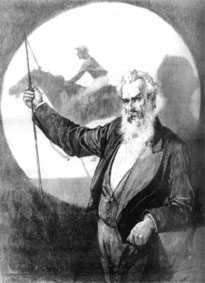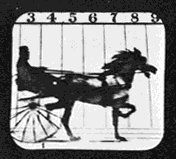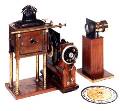|
When a horse is running or trotting, do all four hooves ever leave
the ground at the same time? That was the wager that the former Governor
of California, Leland Stanford had with some of his friends. There was
much controversy in horse racing circles at the time, and though most
people believed that a horse always has one hoof in contact with the
ground, Stanford thought otherwise. Because a horse's legs are moving
so fast, it's impossible to tell just by looking, so he needed a way
to slow down the movement so it could be studied.
In 1872, Stanford offered Eadweard Muybridge, a world-famous
photographer of landscapes $25,000 to find the answer. Muybridge
wasn't quite sure he could set up and perform an experiment to settle
the dispute, but with that much money at stake he agreed to take on the
challenge.
|
 |
In most 19th century cameras, a picture was taken when the photographer
removed the lens cap for several seconds in order to expose the film and
capture an image. The subject had to remain perfectly still during this
time or the resulting photograph would be blurred. In order to capture
very fast action like a galloping horse, the exposure time would have to
be very short.
Muybridge invented a fast shutter mechanism that relied on a small
piece of wood with a hole drilled in it that slid past the lens. The
wood was positioned such that a pin held it in place covering the lens.
When the pin was removed, gravity would cause the wood to drop and as
the hole moved past the lens, the film was exposed for a fraction of a
second.
Muybridge first tried taking a single photograph as a horse ran by, but
he had a difficult time getting any image. He tried various methods of
making the shutter move faster and faster so as to shorten the exposure
time, and as he did the quality of the image began to improve. Finally
he hit upon the idea of using two pieces of wood and slipping them past
each other so quickly that he had achieved an exposure time of about one
five hundredth of a second. That solved the problem of capturing a
reasonably clear image of a horse at a gallop, but it still didn't
provide him with a way to settle the bet.
In 1874, his work was interrupted when he shot and killed his wife's
lover, whom he suspected was actually the father of a male child his
wife had born earlier that year. He was imprisoned until his trial in
February 1875. At the trial he was acquitted, thanks to the lawyer that
Stanford had hired for him, but afterwards he decided to leave the
country for a while and did not continue the experiments until his
return to California in 1877. He then continued his work on increasing
the shutter speed until he had reduced the exposure time to less than
1/2000th of a second.
Once Muybridge was satisfied with the quality of the images, he had to
figure out a way to capture several images in sequence. He decided to
place several cameras in a row all pointing in the same direction and
trigger them in sequence as the horse galloped past. He attached strings
to all the shutters on all the cameras and stretched them across a
track, so that as the horse passed by touching each string in turn, the
cameras would take their pictures one at a time and in sequence.
In 1878, after many experiments during which he made further refinements
to the triggering mechanism and improvements in the sensitivity of
emulsion paper, he succeeded in achieving the results he needed to
settle the bet and collect the $25,000. He had a sequence of 12 images,
and one of them clearly showed that all four of the horse's hooves
were off the ground at the same time. It was the first successful
photographic representation of a sequence of movement and it made him an
international star.

Muybridge's first picture sequence
In 1879 he invented the Zoopraxiscope, a device with counter-rotating
discs that projected the images sequentially. Now one could actually see
a representation of the horse galloping and the effect was truly
stunning. After a public showing in San Francisco a reporter gushed,
"Nothing was wanting, but the clatter of hoofs upon the turf and
the occasional breath of steam to make the spectator believe he had
before him the flesh and blood steeds."

Zoopraxiscope
He continued his experiments using more cameras and photographing the
motions of other animals and later did extensive studies of human
movement. He eventually published his photographs in a portfolio called Animal
Locomotion (1887) and two books; Animals in Motion (1899) and
The Human Figure in Motion (1901). The latter created quite a
stir at the time for it's use of nude male and female models.
Though Thomas Edison is usually credited with creating the first movies
in 1889, it was the work of Eadweard Muybridge, and a $25,000 bet that
provided the cornerstone of Edison's invention and the evolution of
motion pictures.
|






